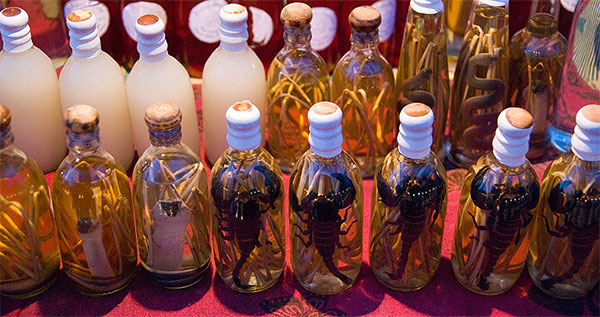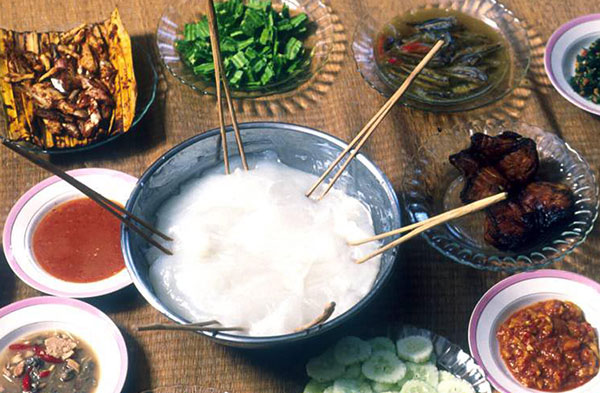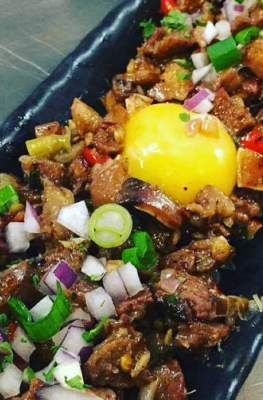Published on August 20, 2013

Southeast Asian cuisine not only offers the sublimely wonderful but also the shockingly weird. For many travellers, challenging their taste buds and assumptions is all part of the fun of a trip to ASEAN. Here are five food challenges to consider for your next Southeast Asian adventure.
Ambuyat: This Bruneian delicacy (pictured below) is derived from the interior trunk of the sago palm. It is a bland gluey substance made from tapioca starch mixed with boiling hot water. The sticky ambuyat is eaten using two-pronged bamboo sticks called chandas; in a twirling motion to get the starch into a ball. The ambuyat is then dipped in sour sauces made from local fruits such as binjai and cencaluk, and various other spicy dips. A popular dip among locals is the sambal tempoyak made from fermented durian. To newcomers, the smell of Ambuyat is unpleasant and many compare its pungency to glue. You be the judge!
Challenge: If battling the pungent combination of ambuyat and durian is not challenging enough for you, why not try ambuyat with budu perut ikan or stuffed fish stomach. Fish guts are cleaned thoroughly, rubbed with salt, and preserved inside a glass bottle. To some the idea of eating stuffed fermented fish stomach is a dare but others find this rare dish a pure delicacy!
Insects and other creepy crawlies: Entomophagy, defined broadly as the practice of eating insects and land-based arthropods, is common in many cultures. More than 1,000 species of insect are known to be eaten in 80% of the world’s nations so it seems that only Western or westernized cultures balk at the practice. Some of the more popular insects and arthropods eaten around Southeast Asia include crickets, cicadas, grasshoppers, ants, various beetle grubs and larvae, and various species of caterpillar, scorpions, and tarantulas. You will see piles of fried insects, spiders, and scorpions on street stalls and markets throughout Southeast Asia. Source: Wikipedia.
Challenge: Within the context of growing numbers of human mouths to feed, perhaps acquiring a taste for insects will put you on the right side of history. Insects comprise a significant chunk of terrestrial animal biomass, offer a great source of protein, and are more efficient than meat to cultivate for food.

Kopi Luwak: The world’s most expensive coffee co-starred alongside Morgan Freeman and Jack Nicholson in the 2007 movie The Bucket List. Genuine coffee aficionados, as opposed to the chain store caffeine-fiend, will no doubt have kopi luwak on their lists of things to try before they die. It is best they travel to Indonesia or the Philippinese for cheaper, but not cheap, prices as it is there they can find responsible producers of genuine free-range kopi luwak. What separates kopi luwak from regular coffee (kopi) is the digestive tract of the Asian palm civet (luwak). Producers argue that civets improve coffee via selection and digestion: Civets choose the best coffee cherries for their fruit pulp, and their digestive systems improve the flavor of the coffee bean. Proteolytic enzymes seep into the beans, making shorter peptides and freer amino acids, which apparently improves falvour. The beans are collected at the other end, cleaned (presumably), and then roasted like any other coffee. Source: Wikipedia.
Challenge: If you can get over the number-two factor, the challenge is finding kopi luwak producers that don’t treat civets like faeces factories. Expect to pay higher prices for the genuine article.
Pla ra: How would you like the liquor of fermented raw fish (pla ra) and possibly a crushed salted paddy field crab (pu) mixed into your delicious green papaya salad (som tam)? If you said no you would be served up som tam Thai, a dish from Bangkok and central Thailand and the default version of green papaya salad most tourists enjoy and rave about. If you said yes then prepare to enjoy som tam pu pla ra, which is possibly the dish closest to the hearts of the Isan people of Northeast Thailand. The key ingredient is pla ra, a sauce made by fermenting freshwater fish in salt and rice bran for between three and 12 months. Pla ra is used in a range of cooked and raw dishes to add depth and complexity. If used in a raw dish like som tam, make sure that the pla ra itself has been cooked before use; homemade pla ra can contain harmful bacteria.
Challenge: Do you want bacteria-ridden dough topped with grated rotten milk and slices of rotten meat? No? Well that’s a pepperoni pizza. The line between fermentation and rot is pretty thin, according to The Economist.
Snake heart & snake or scorpion wine: First rip the beating heart of a serpent from its chest with your teeth and swallow it whole, wash it down with a shot of bile, blood, and rice wine, then enjoy a range of dishes prepared from the skin, bones, ribs, meat, and other innards of the beast. Very little is wasted. This is one of the most confronting gastronomic experiences available in Southeast Asia and has become somewhat of a rite of passage for many young backpackers. More commonly encountered on the streets and in markets are jars and bottles filled with coiled whole snakes steeped in rice wine. The wine is consumed as shots, supposedly to restore vitality and health. Snakes are often substituted or supplemented with scorpions.
Challenge: Is it that disgusting? The freshest raw oysters are still alive when consumed so perhaps taking the heart from a live snake is a more humane death by comparison. Lambs are generally considered cute but many enjoy a lamb chop so why not eat an animal generally thought ugly? And bottles of mezcal, an agave-based liquor closely related to tequila, often contain a caterpillar!






